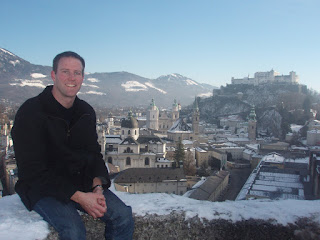



 When I was last in Salzburg in the autumn of 1993, I remember thinking, “What an idyllic little place. It would be fun to spend Christmas here someday.”
When I was last in Salzburg in the autumn of 1993, I remember thinking, “What an idyllic little place. It would be fun to spend Christmas here someday.”Well, that “someday” was last week and Salzburg lived up to it’s yuletide expectations by providing a little bit of snow, all the “glüwein and punsch” one could imagine and most of all, a family of friends from Seattle with whom to spend the actual holiday.
As I was wandering about Salzburg mesmerized by the Christmas cheer - Austrian style, I was struck by the fact that the American idealized vision of Europe, however romantic and unrealistic it might be, is truly captured in this one small city in central Austria. Salzburg simply has it all: a castle/fortress on the hill, cobblestone streets with colored facades, a huge and illustrious Baroque cathedral, non-English speaking locals (but with enough to get by as a tourist), spectacular history and significant figures of history (Mozart was born here and wrote many of his concerts with this very cathedral in mind), Alps all around, a rollicking beer hall with very large steins of locally-made beer, seemingly ceaseless cathedral bells, never-ending arts and culture and a river running right through it. Not even to mention that one of the most beloved movies of all time, The Sound of Music, is the quintessential Salzburg showcase.
And when you add snow, horse-drawn carriages, Christmas markets, lights and the Christmas merriment of this time of year, Salzburg becomes a storybook Christmas city – and on top of all this, the most famous and translated Christmas carol worldwide, Silent Night, was written and first performed in a small church just 20 kilometers from Salzburg in 1818. Silent Night is a very sacred song to the Austrian people.
Add to all this holiday fun my friends from Seattle - Dan and Shena Hinds and her parents, John and Jean McCall - and Christmas in Salzburg was an unforgettable way to celebrate the season.
If I couldn’t be surrounded by family and friends around the Christmas tree in Southern California, Salzburg surrounded by temporary family in the form of good friends was the next best place.
So as we’re on the brink of the new year and Linköpinglivin is a step behind, I wish you one last “Frohe Wiehnachten” from Salzburg, Austria.
Pictures above:
1. The castle on the hill, the Baroque church, a bit of snow - Salzburg plays the part well.
2. The German and Austrian Christmas markets are the world's best (and most expensive).
3. Salzburg plays up its strengths and it knows that tourism is its strongest asset - there is even a store called "Christmas in Salzburg" as well as "Easter in Salzburg" just down the street.
4. My Christmas dinner was spent at St. Peter's Restaurant, one that Charlemagne (yes, Charlemagne!) mentions eating at way back in 803 making this the oldest known restaurant in Europe...
5. A big thanks to my friends Jean, John, Dan and Shena for letting me crash their Christmas party in Salzburg.

















































